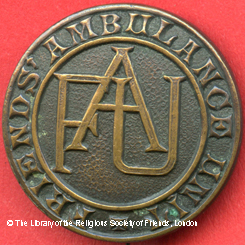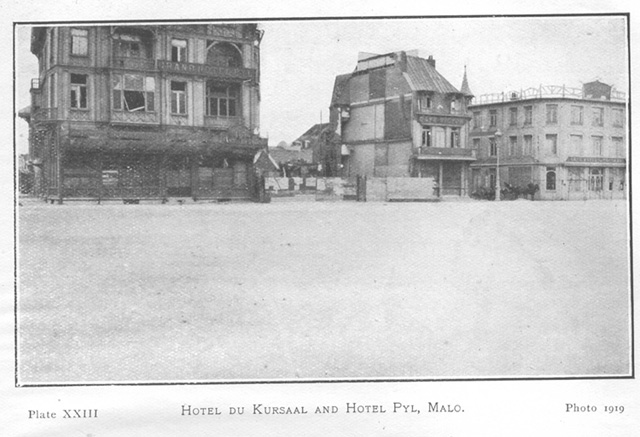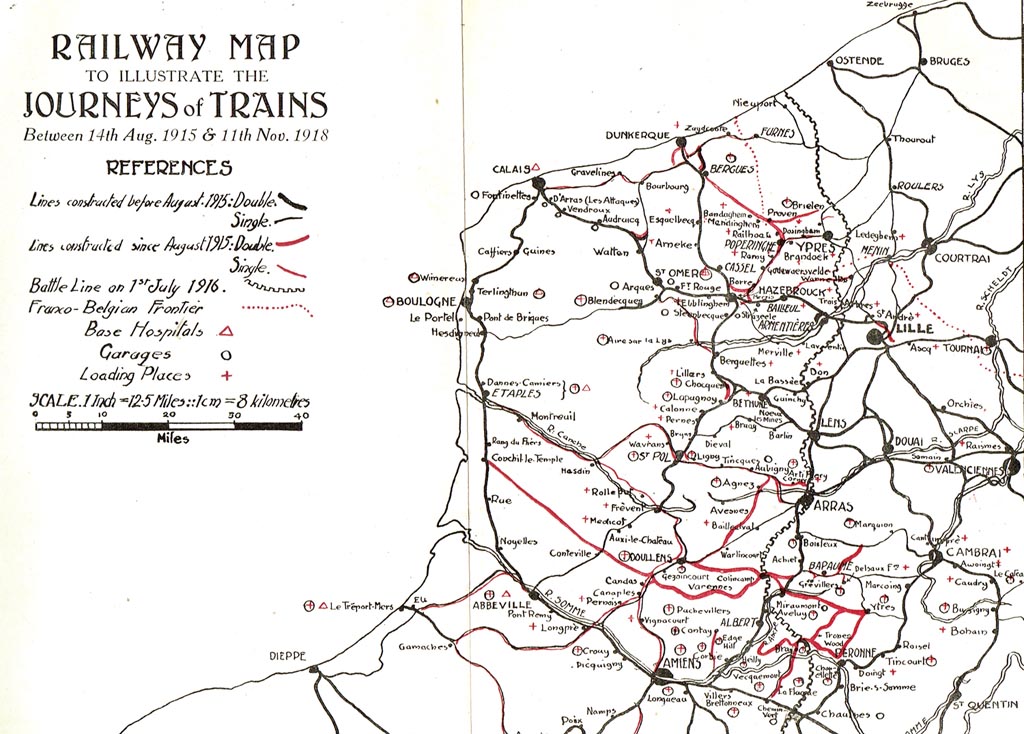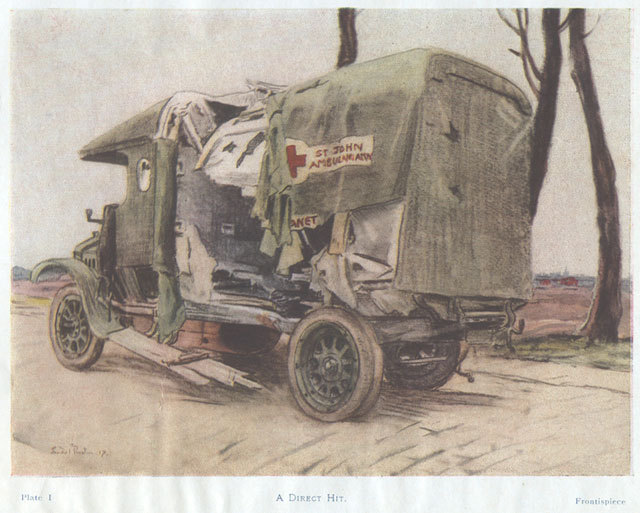|
The Friends Ambulance Unit
1914 - 1919 |
 |
|
As there has been considerable reference to the Friends Ambulance Unit, with a number of the family joining it, at least for some of the WW1, it seems worthwhile giving a quick summary of the organisation and the work that it did in WW1.
The Unit was founded as the "Anglo-Belgian Ambulance Unit" at the start of World War I in 1914 and later renamed the Friends' Ambulance Unit. Members were trained at Jordans, a hamlet in Buckinghamshire, that was a centre for Quakerism. Altogether it sent over a thousand men to France and Belgium, where they worked on ambulance convoys and ambulance trains with the French and British armies. It was dissolved in 1919. Archived is a copy of the original acceptance letter send by Philip Baker to Colin Rowntree inviting him to the initial training starting with First Aid training on 25th August 1914 in London. The first boat load of members went to France on 30th Oct 1914, with the view of giving medical help where needed and do other useful healing work where required. It was understood from the start that they would operate in an orderly semi-military way so as to be acceptable to the military mind and local French and Belgian authorities. Apart from the letters, diaries and documents from Colin Rowntree, most of this summary is derived from the following three sources from the time. The First Report of the FAU Oct 1914 - April 1915 The Story of the Work of the FAU Oct 1914 - April 1915 A book – The Friends Ambulance Unit 1914-1919 The Book, written about the activities of the FAU, in hindsight gives a clear structured approach to what was happening and is an excellent source of detailed information and statistics, however this structure is not apparent in the same way in earlier reports. From a speech on May 2nd 1915 by the O/C, presumably Philip Baker we read "I would point out that roughly they divide every member of the Unit in Dunkerque into four classes, firstly those who are orderlies at St. Pierre, secondly those who are orderlies at Queen Alexandra, thirdly those who drive motor cars, and fourthly, everybody else. I think it will be worthwhile for everyone to discover the class to which they belong, and then discover what they have to do in case of the bombardment beginning." Later in the speech we read the following: "Well, hitherto in the history of the Unit, it has always occurred that the work which we have done has brought in its train more and more opportunities for activity, but on this particular occasion, and at the present time it seems as if our recent endeavours were likely to be followed by the total collapse of every activity in which the Unit has been engaged." And to give an idea of how the organisation managed itself: "A voluntary unit like ours, if it is shelled out of one place, moves on to another, and tries to take the buildings which the army leaves, and the more places that are shelled at once, the fewer buildings are there left, in consequence it is not so easy as it might appear at first to move on, for example, our civilian typhoid hospital to another place out of range, for the vary simple reason that premises elsewhere cannot very easily be found." The First Report and the Story of April 1915 gives some idea of the work being done in the first year of the war. The Events of the first few days are referred to elsewhere in this booklet and well reported in Colin’s diary and amongst the many publications and articles, and it can only be said that this was truly a baptism by fire into the work to follow. One gets the feeling that the organisation, although small, was sufficiently confident to be able to adapt to any situation and observe where there was a need and do something about it. Those at the Headquarters were obviously exceptional people managing, often delicate situations internationally, and the Unit was seen to have performed efficiently. From the first Report: This has been due to various factors, but not least to the interesting variety of expert to be found in the Unit. Professional men, skilled artificers, craftsmen of all sorts, business men, practical workmen, engineers, mechanics and builders, surgical dressers, bearers, orderlies, motorists—all are at hand, and ready and willing to be of service. By April 1915, the FAU had a
well established transport system. Cars and Ambulances all needing work
to keep them running – from the book FAU 1914-19: In the first days of the Unit's existence, the problem of motor repairs was fortunately not a very pressing one. There were not many more than half-a-dozen cars at their disposal, and these were new ones. But negotiations were soon started to secure the use of M. Albert Lenozeh’s garage in the Rue Forbin, almost opposite the entrance to the Hotel du Kursaal, the first Headquarters. As more cars arrived, and as the wear and tear of constant running on the bad roads began to show, the garage work soon became of great importance. More space was needed to cope with the increased number of cars, and the Garage Lenozeh was taken over as a whole, to be known as No. 1 Garage. Its original equipment was augmented by the Unit till it possessed a very serviceable plant. A couple of lathes were installed, a drilling machine, carborundum wheels, charging apparatus, and the necessary driving gear. With the assistance of two engineering firms and a foundry in the locality for machining very large plants or making odd castings, the garage staff was able to deal with practically every sort of mechanical job that arose. Later it was necessary to take additional garage accommodation, but No. 1 from first to last was the centre of the Unit’s workshop activities. The First Report was written only six months after their arrival in Europe and gives a clear idea of the work that the FAU was doing. From the first Report: April 1915 By way of summary of the work accomplished, the following figures may be quoted:
Also from the report we get an idea of the support from the UK particularly through the work of Ella Rowntree and Lady Newman whose husbands were both on the committee for the FAU. Reference to their work together in the North and South of England is made in letters. These figures furnish a preliminary return of the articles supplied Blankets, Rugs, Coverlets . ... 1,564Pillows and Pillow Cases .. 1,712 Sheets .. .. .. 1,042 Pairs of Socks and Stockings .. .. 4.463 Shirts (day and night) and bed jackets 6,036 Vests and Pants .. .. 1,212 Mufflers, Comforters, etc. .. 2,842 Handkerchiefs .. .. .... 2,530 Towels .. .. ... . 1,265 Miscellaneous, Suits, Dresses,Children’s Clothes, Boots and Shoes Underclothing, etc. ... . 8,101 Most of these articles were new and specially prepared for use in the Unit’s relief work.
Quote from FAU 1914-1919 It would hardly be an overstatement to say that up to the spring of 1915 the Unit had lived mainly on emergencies. The civilian work at Ypres and Poperinghe like the French Convoys had grown from no pre-arranged plan… There was no reference to the term "French Convoys" in the April 1915 Report or the Story, however reading into what was happening and from Colin Rowntree’s diaries it would seem that he spent a lot of his time driving and ferrying ill civilians, orphans and and the wounded about as well as helping in the various hospitals. These Convoys derived from the "Section Sanitaire Anglaise" that formed in 1915 and consisted of the Hon. Lionel Holland’s Ambulances working with the French system. Lionel Holland was the brother of Sydney Holland, Lord Knutsford, who was Chairman of the London Hospital House Committee for many years. It can be presumed, but uncertain, that some of Colin’s work was to be part of the "French Convoys", work that was seen as a significant part of the FAU work. The FAU set up a number of hospitals both civilian:
and military:
as well as servicing First Aid stations, Postes de Secours and Casualty Clearing Stations near the front line.
The FAU give anti-typhoid inoculations, dealt with water purification and took on the job of milk distribution because of the serious conditions prevailing among infants. The list of activities related to general relief work, in which the FAU was involved, is extensive and includes clothing and food distribution, search parties, schools and offering outpatient facilities. The Ambulance Trains
It is astounding to consider that such a small organisation and a voluntary one, at that, could take on, in wartime the running of trains. However by the end of 1915 the FAU was running one Ambulance train and over the next year or so, took over the running of three more. A letter from Annie Rowntree to Colin refers to one of these trains, on which the injured Laurie Rowntree traveled, as being Ralph Thorp’s train so presumably his work with the FAU was on one of the trains. In the letters of Lionel Dibdin, there is mention that he, after recouperating sufficiently from being gased, was conducting troops to Le Havre on the trains and then back to Paris. The statistics regarding the work of these trains is equally astounding.
|
|


 As
well as these hospitals, there were orphanages established and the
problem of hospitals and orphanages being damaged by shelling and bombs,
so patients, children and nuns etc had to be moved. There was a lot of
civilian evacuation transport work.
As
well as these hospitals, there were orphanages established and the
problem of hospitals and orphanages being damaged by shelling and bombs,
so patients, children and nuns etc had to be moved. There was a lot of
civilian evacuation transport work.




